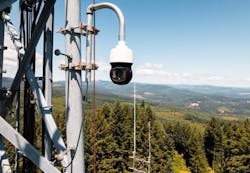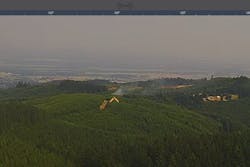As reported last year, Portland General Electric (PGE) is continually improving its infrastructure and operations, while providing a unique resource to first responders through its comprehensive approach to wildfire mitigation across its service area, including partnering with technology firm Pano AI to use ultra-high-definition cameras, satellite imagery, and artificial intelligence in detecting and responding to wildfire threats. Here we discuss a real-world success story.
PGE, Oregon’s largest electric utility serving over 900,000 customers, is a leader in the electric utility wildfire mitigation space in the Pacific Northwest by integrating advanced technological solutions into its wildfire mitigation strategy.
The Threat of Wildfires in Oregon
Utilities are increasingly vulnerable to wildfires due to their extensive networks of critical infrastructure sprawling across vast, often remote and forested areas. Oregon's verdant landscapes, characterized by dense forests and scenic beauty, are increasingly at risk of wildfires fueled by climate change, drier conditions, and an accumulation of forest underbrush. These potential fires threaten not only the natural environment but also thousands of homes and critical infrastructure.
Recognizing the existential need for enhanced wildfire management, PGE has sought solutions to strengthen its grid resilience and the communities it serves. The utility's wildfire mitigation strategy is comprehensive, focusing on enhanced vegetation management, infrastructure hardening, and expanded situational awareness including cutting-edge remote sensing technology.
Uniting Technology and Tradition for Enhanced Wildfire Management
Part of PGE's innovative wildfire mitigation program is an advanced integrated early fire intelligence solution that shares critical early detection alerts, incident location relative to PGE’s assets, and powerful visual intelligence, including Pano AI’s 30X optical zoom capabilities. The system provides situational awareness not only to PGE employees but also to federal, state, tribal, and local governments, including various fire agencies throughout the company’s service area. This comprehensive initiative allows PGE to provide unique support to communities and customers during fire season while offering first responders and fire managers innovative tools for wildfire mitigation, preparedness, response, and recovery.
Dan Nunez, senior manager, wildfire planning and analytics at Portland General Electric said, "Our goal is to deliver safe and reliable power, particularly in the face of increasing wildfire threats. Integrating advanced detection technology into our wildfire mitigation and safety program is a game changer, enabling us to identify potential fire starts faster, empowering first responders to respond with precision, while protecting our assets."
The Role of AI in Wildfire Mitigation
One piece of PGE’s comprehensive wildfire strategy is a network of 33 ultra-high-definition, mountaintop cameras, a number expected to grow to 35 by year's end. Strategically placed throughout PGE’s High Fire Risk Zones, these cameras use artificial intelligence to detect smoke and potential fires from up to 10 miles away.
Pano AI is a San Francisco-based company that is building wildfire situational awareness tools. PGE camera feeds are integrated with satellite data, third-party data, and proprietary smoke and fire detection AI algorithms. The imagery is then sent to a 24x7 human intelligence center, where experts differentiate smoke from other atmospheric conditions, such as morning fog or dust. Once confirmed, the ignition location data is triangulated and the distance between the incident and nearby assets is calculated. This actionable information is sent to both PGE dispatch and local fire agencies allowing each group to make informed decisions about how to respond.
These alerts have proven to reduce response times by minutes or hours, which enables fire response to implement an earlier attack, likely reducing the overall fire impact and contributing to quicker containment.
The deployment of wildfire situational awareness tools across PGE’s service area is a logistical endeavor that underscores both the companies' commitment to innovation and safety. The system integrates seamlessly with PGE’s existing infrastructure, providing an overlay of intelligence that enhances the capability to continuously monitor the service area.
Strategic Fire Management, A Rapid Initial Response
According to the U.S. Forest Service, a vigorous initial response to a wildfire, often referred to as "initial attack," can significantly reduce the risk of the fire escalating and inflicting extensive damage. The success of an initial attack largely hinges on the swift deployment of appropriate firefighting resources.
Key to PGE’s responsive measures is the precision- integrating cameras, artificial intelligence, and intuitive software in determining the exact location of a potential fire and assessing the distance between the fire and critical infrastructure. This capability enables timely decisions, such as deploying additional resources to add fire-proof cladding to protect vulnerable poles in the fire path. Actions such as that could help limit the overall fire impact to the utility’s electric system and potentially reduce financial recovery.
A Real-World Success Story
Efficacy of the wildfire situational awareness tools were demonstrated during the Holaday Fire Incident where a small ignition was detected near a residential area outside Portland, Ore. The cameras quickly identified unusual smoke patterns through triangulation of multiple camera views and alerted PGE’s control center. Within minutes, Pano, equipped with real-time footage of the fire’s progression, was able to pinpoint the ignition source, and notify local fire departments.
This human-caused ignition occurred in a High Fire Risk Zone during a red flag event, increasing the risk of spread. Pano’s alert coincided with the first public call to emergency dispatch; however, the call lacked specific location details. Within five minutes, the alert provided the missing information and incident triangulation. With eyes in the sky, the alert details guided crews, enabling the dispatcher to watch and guide first responders straight to the location of the fire.
PGE used asset data map overlays to see if nearby utility infrastructure could be at risk if the fire were to spread. The real-time check revealed that PGE had powerlines a half mile away. With this intelligence at hand, PGE mobilized quickly to protect its infrastructure and the surrounding communities by preparing to shut power lines if needed. Ultimately, a shutdown was not implemented as the alert afforded fast and efficient containment efforts, reinforcing the critical role of early detection coupled with immediate, detailed, and actionable intelligence.
"The rapid response and seamless coordination between Pano AI’s technology, our team, and the local fire departments prevented what could have been a severe fire," Nunez recounted. "It was a testament to the value of this partnership and our ongoing efforts to safeguard our communities."
The incident not only highlighted the system's precision and efficiency but also reinforced the critical role of advanced technology in wildfire detection and management. The success of this intervention prevented potential property damage and loss of life, illustrating the tangible benefits of PGE's investment in state-of-the-art technology.
Collaboration with Local Fire Agencies
Collaboration with local fire agencies has been pivotal. Division Chief Phil Schneider of the Clackamas Fire District noted the transformative impact of wildfire situational awareness technology: Schneider says, “I've used Pano AI's system countless times over the past year to share early detection and location data with our partners and to send the incident camera feeds to the on-scene commanders in growing vegetation fires. This technology is a game changer for the fire service by allowing us to get eyes on the fire within minutes of smoke becoming visible. The alerts and imagery allow us to dispatch resources before 911 calls come through, and we're able to right-size our response based on how smoke is showing on the cameras.”
A Model for Future Fire Safety Efforts
As PGE continues to expand its use of advanced technologies for wildfire mitigation and management, its efforts serve as a model for other utilities nationwide. The proactive measures undertaken by PGE are setting new standards for how utilities can utilize technology to adapt to a changing environment and mitigate threats to not only its infrastructure but the communities it serves as well.
"This is more than just an investment in technology; it's an investment in our future safety and resilience," added Nunez. "By implementing our mitigation strategies, we are not only protecting our infrastructure and customers but also leading the way for others in our industry."
PGE’s commitment to wildfire mitigation and community safety is reflected in its ongoing investments to harden its systems, expand situational awareness, and bolster collaboration with public safety partners. Through its innovative use of advanced technologies like artificial intelligence. PGE is setting a benchmark in utility management and community protection, helping to make Oregon a safer place during wildfire season.
Sonia Kastner is the CEO and Co-Founder of Pano AI, a developer of early wildfire detection, enabled by AI. Previously, Sonia spent over ten years building and leading supply chain and manufacturing organizations within fast-growing, mission-driven start-ups. Her global leadership experience spans Nest Thermostats, multiple solar energy companies, and extensive consulting across the IoT ecosystem. Prior to starting her career in technology, she worked in economic development for New York City under Mayor Michael Bloomberg. Sonia has a BA in physics from Harvard University and an MBA from the Stanford Graduate School of Business.
About the Author
Sonia Kastner
Sonia Kastner is the CEO and Co-Founder of Pano AI, a developer of early wildfire detection, enabled by AI. Previously, Sonia spent over ten years building and leading supply chain and manufacturing organizations within fast-growing, mission-driven start-ups. Her global leadership experience spans Nest Thermostats, multiple solar energy companies, and extensive consulting across the IoT ecosystem. Prior to starting her career in technology, she worked in economic development for New York City under Mayor Michael Bloomberg. Sonia has a BA in physics from Harvard University and an MBA from the Stanford Graduate School of Business.




